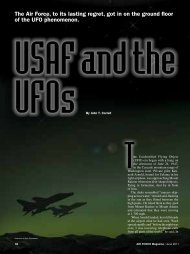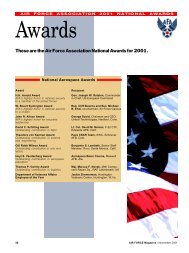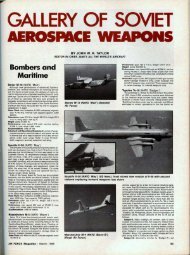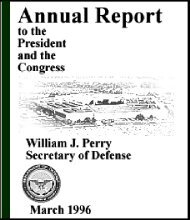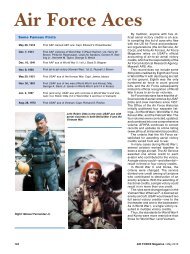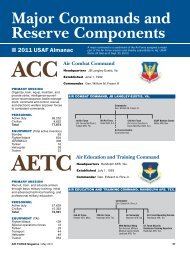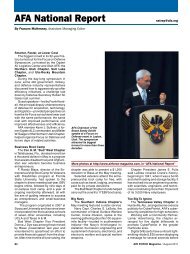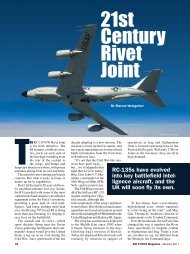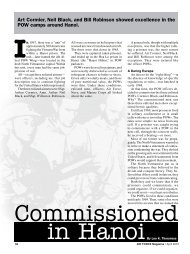0701crash - Air Force Magazine
0701crash - Air Force Magazine
0701crash - Air Force Magazine
You also want an ePaper? Increase the reach of your titles
YUMPU automatically turns print PDFs into web optimized ePapers that Google loves.
Lockheed photo<br />
The <strong>Air</strong> <strong>Force</strong> tightly managed the aftermath of two F-117 crashes in the mid-<br />
1980s. By the time an F-117 was shot down during Allied <strong>Force</strong>, Pentagon<br />
officials said there was little need to take measures to protect its secrets.<br />
airplane that had supplanted Oxcart<br />
in 1968. Their mission was to perform<br />
peripheral reconnaissance of<br />
Southeast Asia. Not long into their<br />
flight, they experienced a series of<br />
problems that forced them to bail<br />
out about a half-mile off the coast of<br />
the Philippines. Fortunately, they<br />
were rescued in good condition by<br />
Filipino fishermen and eventually<br />
made contact with the US authorities.<br />
At times, their experience became<br />
surreal. It included standing in<br />
flight suits to make a call from a<br />
town’s only public telephone.<br />
The airplane, however, had no<br />
parachute to brake its fall. When it<br />
smashed into the water, both engines<br />
sent the sensors and other equipment<br />
through the airplane’s upper<br />
surfaces. Those items were distributed<br />
across the ocean’s bottom at<br />
varying distances from the primary<br />
wreckage.<br />
By 1989, the SR-71A’s existence<br />
had been acknowledged for 25 years.<br />
It remained the most advanced reconnaissance<br />
aircraft in the world,<br />
by a large margin. It carried optical,<br />
radar imagery, and signals intelligence<br />
sensors as well as defensive<br />
systems to allow it to operate over<br />
hostile territory. It was not an airplane<br />
that the US would want to<br />
allow material exploitation specialists<br />
in Moscow or Beijing to have in<br />
their hands.<br />
On their way to Clark AB, Philippines,<br />
House and Bozek had the helicopter<br />
in which they were riding<br />
62<br />
fly over the area of the crash. A P-3<br />
also conducted search operations, as<br />
did a couple of naval vessels. Sonar<br />
operations on April 29 and 30 located<br />
the debris. USS Beaufort, a<br />
280-foot salvage ship, equipped with<br />
10- and 15-ton cranes, was directed<br />
to the site to extract the wreckage, as<br />
well as locate the sensors and defensive<br />
systems. Navy SEALs were<br />
aboard, since the recovery operations<br />
were conducted near a portion<br />
of the Philippine coast controlled by<br />
the Communist New People’s Army.<br />
On May 2, both SR-71 engines were<br />
lifted out of the ocean and swung<br />
over onto the Beaufort. Two days<br />
later, salvagers brought up many of<br />
the sensors. The forward fuselage<br />
section was recovered May 7 and the<br />
main structure was raised the next<br />
day.<br />
Shootdown<br />
Another F-117A crashed March<br />
27, 1999, but this crash was quite<br />
different from those which took the<br />
lives of Mulhare and Stewart. The<br />
airplane did not crash in the western<br />
United States, but in northwest Yugoslavia,<br />
near Novi Sad. The cause<br />
was not fatigue or pilot error but<br />
hostile action—specifically, a Serb–<br />
launched surface-to-air missile.<br />
The most significant contrast was<br />
that the pilot was able to bail out<br />
and survive. Search and rescue<br />
teams were dispatched on specially<br />
equipped HH-60 Black Hawk helicopters<br />
and HH-53 Super Jolly<br />
Greens on a clandestine recovery<br />
mission. The helicopters were protected<br />
by a contingent of fighter aircraft<br />
as they headed toward the crash<br />
site. Fortunately, they were able to<br />
rescue the pilot, which produced a<br />
“huge sigh of relief,” according to<br />
the Pentagon’s chief spokesman at<br />
the time, Kenneth Bacon.<br />
There was no hope of recovering<br />
an airplane downed in hostile territory,<br />
but to the surprise of some, the<br />
<strong>Air</strong> <strong>Force</strong> made no attempt to bomb<br />
the wreckage into oblivion. By 1999,<br />
of course, the existence of the F-<br />
117A had been acknowledged for<br />
more than a decade, and stealth fighters<br />
often appeared at air shows. A<br />
1988 CIA assessment had concluded,<br />
“The Soviets likely have a good understanding<br />
of US stealth programs<br />
and technology from successful<br />
Western technology acquisitions.”<br />
Senior Pentagon officials argued<br />
that it was no longer necessary to<br />
protect the F-117’s 1970s vintage<br />
low observable technology or its infrared<br />
targeting system. At a Pentagon<br />
briefing, then–Maj. Gen. Bruce<br />
Carlson, the <strong>Air</strong> <strong>Force</strong>’s director of<br />
operational requirements, observed<br />
that if Serbia passed some of the<br />
airplane’s technology to Moscow,<br />
the effect would be “minimal.”<br />
Others were less sanguine. Destruction<br />
of the wreckage would,<br />
according to some analysts, have<br />
prevented reverse engineering of the<br />
sensitive technology carried on the<br />
airplane and the radar absorbent<br />
materials. An anonymous <strong>Air</strong> <strong>Force</strong><br />
official was reported to say, “It’s<br />
our normal practice to bomb the<br />
wreckage when there is sensitive<br />
equipment on the aircraft.” A pilot<br />
who expressed surprise that the remains<br />
were not bombed wondered if<br />
the US had the coordinates of the<br />
wreckage site.<br />
Within a week, the wreckage site<br />
was visited by a Russian trade delegation<br />
to Yugoslavia, and materials<br />
and system components were<br />
salvaged. What, if any, benefit Moscow<br />
might have gained remains to<br />
be seen. ■<br />
Jeffrey T. Richelson is a senior fellow and consultant of the National Security<br />
Archive in Washington, D.C., and author of nine books on intelligence and<br />
military topics. This is his first article for <strong>Air</strong> <strong>Force</strong> <strong>Magazine</strong>.<br />
AIR FORCE <strong>Magazine</strong> / July 2001


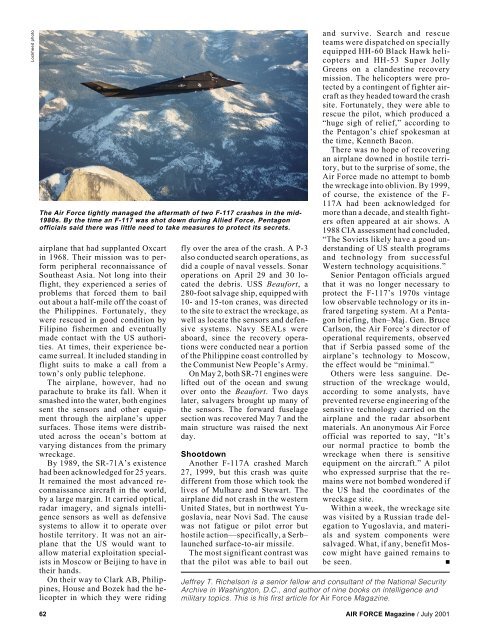
![[PDF] Foulois - Air Force Magazine](https://img.yumpu.com/13391007/1/190x253/pdf-foulois-air-force-magazine.jpg?quality=85)
